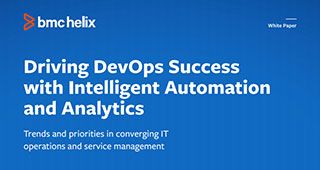I’ve previously looked at the simple but powerful idea that there is an inverse relationship between IT maintenance and management costs (M&M) and an organization’s competitiveness. This idea was reported in a recent Forbes Insights survey which noted that “Three out of four executives agree that the amount of time, money and resources spent on ongoing maintenance and management—versus new project development or new initiatives—is affecting the overall competitiveness of their organization.”
The premise is that the more you can reduce maintenance and management costs, the more money you’ll have available for new project development or new initiatives that service the entire enterprise. Today, let’s look at six common strategies organizations are using to reduce their M&M costs and increase their competitiveness.
(This article is part of our IT Cost Management Guide. Use the right-hand menu to navigate.)
About the Forbes Insights survey
The 2017 Forbes Insights survey focused on the state of information technology service management (ITSM). It surveyed 261 senior-level executives from around the world, representing organizations at various revenue levels from small (<$500 million) to large (> $5 billion), and its survey results can serve as a proxy for the state of IT and ITSM worldwide.
Six big strategies
In addition to identifying the inverse relationship between M&M costs and competitiveness, the survey also identified these six common strategies being used by survey respondents for reducing M&M costs.
- Moving to cloud-based services
- Implementing a higher level of automation
- Shifting staffing to outside contractors and consultants
- Implementing DevOps and Agile practices
- Using microservices, containers, or virtualization
- Extending ITSM capabilities to more parts of the enterprise
These strategies can serve as a working template for anyone looking to decrease their own M&M costs.
Here’s how each strategy reduces M&M costs to increase competitiveness.
Strategy #1: Moving to cloud-based services
M&M cost reduction occurs in the following areas when you move in-house IT servers and services to the cloud.
- Cost shifts from Capital Expenditures (CapEx) to Operating Expenditures (OpEx) – Moving to the cloud reduces capital expenditures for servers and related network equipment, transforming capital costs to monthly operating expenses.
- Reduced setup and labor costs – Setup relates to service configuration and delivery only, rather than setting up a server and hardware infrastructure for service delivery. M&M labor costs are handled by the cloud provider on an as-needed basis, instead of using dedicated staff.
- Expansion costs – Cloud providers can furnish additional capabilities such as more disk, CPU, memory, and communication lines faster (and possibly at a lower cost) than you would be able to for in-house servers and infrastructure.
- Peak demand – Cloud providers can quickly furnish temporary capacity increases as service demand peaks. With in-house servers, you must provide excess capacity to handle peak demand.
Moving to the cloud generally reduces capital, setup, labor, and expansion costs in exchange for monthly costs.
Strategy #2: Implementing a higher level of automation
Data Center Automation (DCA) reduces the need for manual configuration and processing. DCA tools can automate many M&M functions, including.
- Job and process scheduling
- System and job monitoring
- Maintenance, including patching and updating
- Service provisioning and configuration
- Application service delivery
- Workload on-demand, to increase capabilities during peak traffic
Automation replaces labor costs with software and configuration costs.
Strategy #3: Shifting staffing to outside contractors and consultants
When shifting in-house work to consultants and contractors, you only contract for the work you need and the contractor/consultant is no longer on the payroll after the project completes.
Strategy #4: Implementing DevOps and Agile practices
DevOps and Agile practices generally break down organizational silos between software developers and IT operations personnel. DevOps and Agile are collaborative practices, focusing on faster time-to-market, lower failure rates, rapid updates and fixes, and quicker recovery from system issues. They pave the way towards an application-centric infrastructure that is built around improving application and service delivery rather than managing servers, switches, firewalls, and telecommunications lines.
Strategy #5: Using microservices, containers, or virtualization
Virtualization hosts multiple virtual instances (Virtual Machines, VMs) of an operating environment on the same machine, reducing the number of physical servers needed.
Containers isolate applications from the environment they reside in, making them stateless. In a container environment, you install only what you need to run an application, nothing more. Containers can be deployed quickly inside VMs, in the cloud, or inside a physical machine, providing a separate application and network environment without running a VM for each application. A container’s smaller infrastructure footprint provides a more secure and easier to configure environment.
Microservices architecture deploys applications as a series of small and independent modular services that run unique processes and communicate through lightweight protocols, making applications easier to understand, develop, and test.
Like DevOps and Agile practices, these architectures support continuous deployment and deployment outside of the traditional IT infrastructure, reducing M&M costs and allowing applications to be quickly deployed in several different environments.
Strategy #6: Extending ITSM capabilities to more parts of the organization
In surveyed organizations, service management is being used to provision and provide services wherever they are needed across the enterprise, not just for IT services. These organizations are deploying service management for customers, business partners, and internal users in the following areas:
- Customer service and support
- Human resources/human capital
- Financial services
- Sales/marketing
- Supplier management
- Training
- Facilities
- Procurement/purchasing
- Operations
Enterprise-wide ITSM is becoming a platform that enables services, updates, events, incident management, and provisioning for the entire enterprise. Service management is becoming more holistic, growing and encompassing services both inside and outside the IT department, leveraging ITSM technology.
And so it goes
The inverse relationship between IT M&M costs and an organization’s competitive positioning is just one of the more interesting findings in the Forbes Insights survey. Today’s post is part of a continuing series examining the survey’s findings. I’ll look at other survey findings in later posts.







